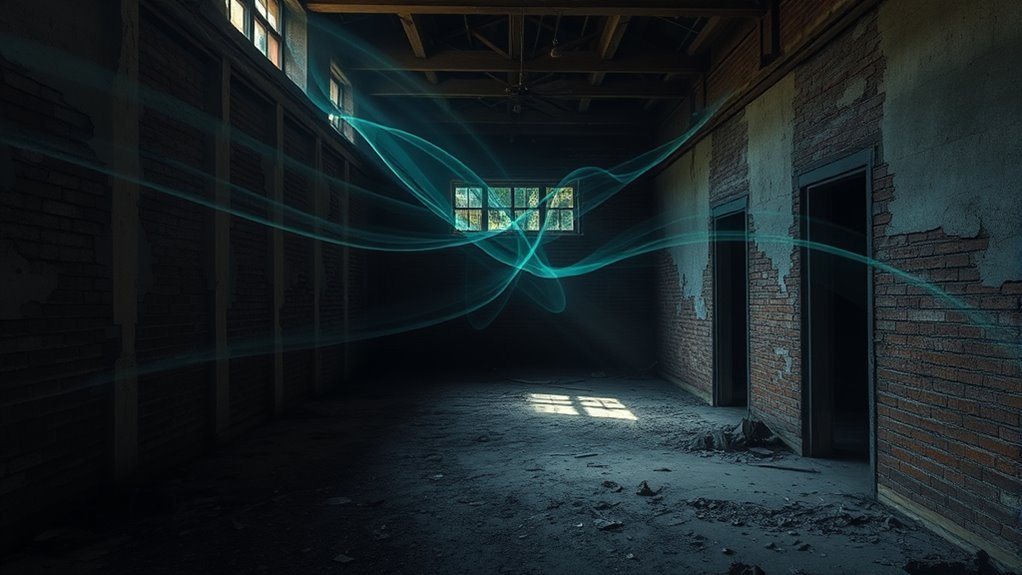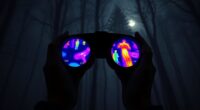In abandoned sites, ultrasound exposure occurs from residual equipment or leaks that can still emit high-frequency sound waves. These waves penetrate materials and tissues, potentially causing biological effects like tissue heating or cellular disruption, especially with prolonged exposure. Damaged or malfunctioning devices make it hard to predict ultrasound levels, increasing health risks. Understanding these mechanisms helps you recognize the hazards lurking in such environments—exploring further reveals how to stay safe around these hidden ultrasound sources.
Key Takeaways
- Abandoned sites may contain residual ultrasound emissions from faulty or damaged equipment.
- Ultrasound waves can penetrate materials, potentially causing biological tissue heating or mechanical damage.
- Unregulated ultrasound exposure risks are heightened without safety controls or inspections.
- Damaged devices can emit uncontrolled ultrasound levels, increasing health hazards for individuals nearby.
- Long-term exposure to ultrasound in abandoned environments can lead to tissue effects like heating and cellular disruption.

Abandoned sites often harbor hidden dangers, and one lesser-known risk is exposure to ultrasound waves. While most people associate ultrasound with medical imaging, these high-frequency sound waves can be present in derelict environments due to leftover equipment or residual sources. If you venture into these areas, understanding the biological effects of ultrasound exposure becomes essential. Ultrasound waves can penetrate tissues and materials, and prolonged or intense exposure may lead to biological effects such as tissue heating or mechanical disruptions at a cellular level. Although most safety standards aim to limit exposure in medical settings, abandoned sites rarely have controlled environments, making unintentional exposure more likely. Recognizing the risks associated with ultrasound waves helps you stay cautious and avoid potential health issues, especially if you encounter damaged or abandoned ultrasound equipment.
Abandoned sites may emit ultrasound waves, posing health risks through tissue heating and mechanical disruptions.
In these environments, equipment safety is often overlooked, which amplifies the danger. Old or broken ultrasound devices may still emit waves, or residual equipment might be leaking signals without your knowledge. Since equipment safety isn’t routinely maintained or inspected in abandoned sites, the possibility of exposure increases. This equipment can malfunction or produce unintended emissions, exposing you to ultrasound waves that aren’t intended for environmental exposure. Without proper shielding or safeguards, you might unknowingly be subjected to these waves for extended periods, heightening the risk of adverse biological effects. As a result, it’s essential to approach abandoned ultrasound equipment cautiously, recognizing that even seemingly inactive devices could pose health hazards if they emit ultrasound waves.
Understanding the biological effects of ultrasound exposure also involves knowing how these waves interact with biological tissues and the environment. Ultrasound can cause localized heating, which might seem harmless but can be damaging with enough intensity or duration. Mechanical effects, like cavitation or disruption of cellular structures, could also occur, especially if the equipment is damaged and emits uncontrolled waves. This makes it even more important to consider equipment safety; damaged devices are unpredictable and may produce higher levels of ultrasound waves than the equipment was originally designed for. Avoiding contact with or disturbance of ultrasound equipment in abandoned sites protects you from unintended exposure to these waves.
Ultimately, recognizing these safety issues isn’t just about avoiding immediate discomfort but about protecting your health in the long run. The biological effects of ultrasound are real, and exposure in abandoned sites is less regulated and more unpredictable. By staying aware of equipment safety and understanding the potential biological impacts, you can better navigate these environments and minimize risks associated with ultrasound waves. Careful observation and cautious behavior are your best defenses against hidden dangers lurking in abandoned sites.
Frequently Asked Questions
How Does Ultrasound Differentiate Between Living and Non-Living Tissues?
You can see that ultrasound differentiates between living and non-living tissues through tissue differentiation and ultrasound specificity. When imaging, ultrasound waves reflect differently off of tissues based on their density and composition. Living tissues, with their unique structures, produce distinct echoes, allowing you to distinguish them from non-living materials. This specificity helps your ultrasound device create clear images, highlighting the differences essential for accurate diagnosis or analysis.
Are There Long-Term Health Effects From Repeated Ultrasound Exposure?
Repeated ultrasound exposure can have unknown long-term health effects, especially with chronic exposure. You might experience biological impacts like tissue heating or cellular changes, but research is still ongoing to fully understand these risks. While short-term effects are generally minimal, continuous or high-intensity ultrasound could potentially lead to health issues over time. It is crucial to monitor exposure levels and follow safety guidelines to minimize any adverse biological impacts.
What Equipment Is Used to Measure Ultrasound Levels in Abandoned Sites?
You use ultrasound sensors and measurement devices to accurately gauge ultrasound levels in abandoned sites. These specialized tools detect and quantify ultrasound emissions, helping you assess potential risks. Ultrasound sensors are handheld or fixed, providing real-time data, while measurement devices may include oscilloscopes or spectrum analyzers for detailed analysis. By deploying these tools, you guarantee safety and compliance with health standards in environments with elevated ultrasound activity.
Can Ultrasound Exposure Affect Local Wildlife in These Areas?
You might not realize it, but ultrasound exposure can subtly influence local wildlife, leading to wildlife disruption and potential ecosystem impact. Animals sensitive to sound may alter their behaviors, affecting feeding, mating, or migration patterns. While ultrasound’s effects aren’t fully understood, it’s clear that prolonged exposure could disturb habitats. Recognizing these risks helps you consider how human-made sounds might quietly shape the delicate balance of abandoned sites’ ecosystems.
How Do Environmental Factors Influence Ultrasound Propagation in Abandoned Sites?
Environmental factors like soil composition and air currents substantially influence ultrasound propagation in abandoned sites. You’ll notice that dense or moist soil absorbs or scatters ultrasound waves, reducing their range. Meanwhile, air currents can bend or distort the waves, impacting their effectiveness. To optimize ultrasound use, you need to take into account these factors, adjusting equipment and deployment strategies accordingly to guarantee accurate and safe applications in these environments.
Conclusion
As you explore abandoned sites, understanding ultrasound exposure offers a subtle glimpse into unseen worlds. While the science reveals gentle whispers rather than loud revelations, it hints at mysteries still waiting to be uncovered. Embrace the intrigue, knowing that beneath the surface, quiet forces shape what we see—and what remains hidden. Sometimes, the most fascinating stories are told in whispers, inviting you to listen closely and discover secrets lingering just out of sight.









